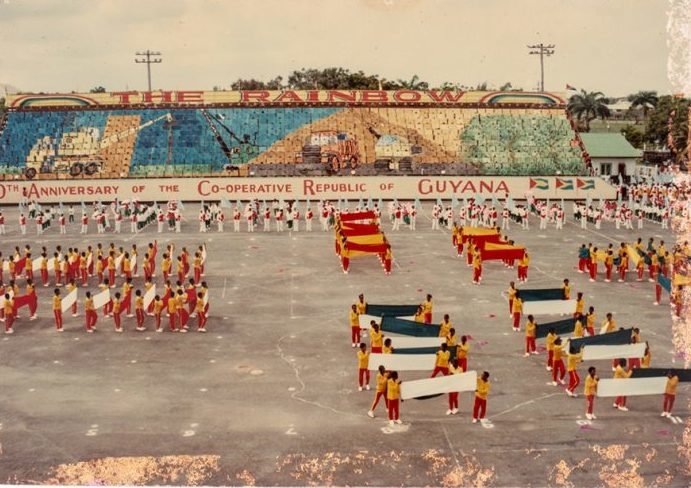
America has baseball, Britain has cricket, north Korea has the mass games. I’d go so far as to say that there is nothing so quintessentially north Korean than those immense displays of co-ordination, political ideology and sheer pageantry. However, much like how neither baseball nor cricket are exclusive to their home nations, the mass games are hardly exclusive to north Korea. Sure. We’ve already talked about how close ally Romania held their own mass games during the cold war, but there’s another ally who did the same. One far more close to their arch-rival the US. Here’s the Guyana mass games.
Co-Operative Republic of Guyana

Okay, so first we need some context! How the hell did this even happen? Well, I explained some of this in my outrageously long blog on socialist countries, specifically the bit on places with constitutional references to socialism. Put simply, the west thought that Guyana was becoming Marxist, so they backed the opponent of the seemingly Marxist guy. What they didn’t anticipate was that the guy they backed, Forbes Burnham, would suddenly take a leftward shift that pushed him way to the left of what his opponent had ever actually intended. In 1970, the country became the ‘Co-Operative Republic’ and began courting relations with many socialist governments abroad, including north Korea.
Guyana positioned itself as part of the ‘non-aligned movement’, meaning it was considering itself largely outside of the Cold War binary of east or west. It certainly had more dealings with the eastern bloc than it did with the west, but it wasn’t part of the socialist common market, nor was it involved in any military pacts. Guyana’s primary interest was in African liberation, something it devoted considerable expense to with little return. Another country that had been trying to avoid being lumped in too closely with the eastern bloc was, of course, north Korea. Even Guyana’s much closer ally Cuba was much too pro-Soviet to be dealing with, especially with America right on their doorstep. Korea was a milder and much safer alternative.
Guyana’s Relationship with Korea
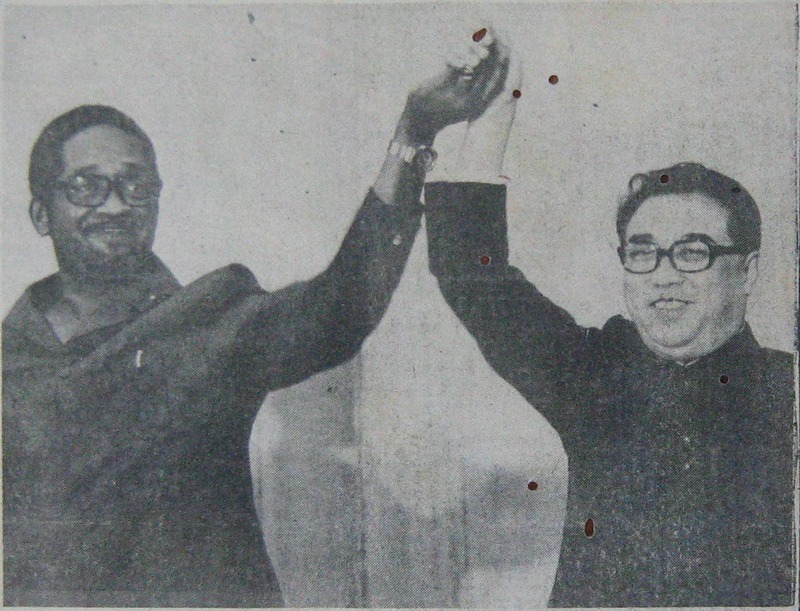
In truth, their political models had some similarities. Both championed a unique adaption of socialism to their own conditions. North Korea had Juche and Guyana had the co-operative system. These ideologies were championed by a central figurehead, respectively Kim Il-Sung and Forbes Burnham. Both were also highly focused on the notion of self-reliance, pushing strongly for as much self-sufficiency as could reasonably be achieved and avoiding strong trading ties with either the eastern or western blocs. It was natural that the two would start to co-operate and even develop strong diplomatic ties, leading to the Guyana mass games.
North Korea especially had motivation for these ties. Bordering both China and the USSR, while receiving the bulk of their trade from both, they were reluctant to swing too closely in either direction, owing to the Sino-Soviet split. Their political position between the two was largely unchanged from the end of the Korean war, with any criticism for either party being left internal rather than external. This meant north Korea focused its efforts far more heavily on non-aligned allies to position itself on the world stage. The aforementioned Romania was a maverick figure, outside of Soviet influence. Tentative ties were made with Yugoslavia during their detente with the USSR and while Cuba was closely respected, its closeness with the USSR made strengthened ties undesirable. Guyana, having strong relations with neither socialist camp, proved perfect for them.
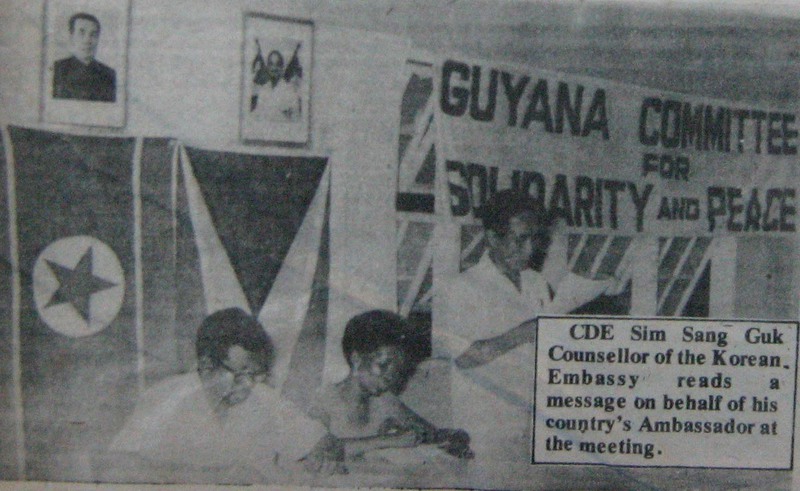
Relations bloomed and soon, trade was being done on a mass scale. In return for raw materials, north Korea sold machinery, crops and weaponry to Guyana in the most unprecedented level of trade between the DPRK and the western hemisphere in history. Students from Guyana studied in Pyongyang and professionals from Pyongyang began to work in Guyana, with allegations going so far as to suggest that north Korean troops were stationed along the Guyana border. Juche study groups emerged, cultural exchanges were rampant and even construction projects began under Korean oversight. I don’t think it’s an exaggeration to say that this was the most successful foreign policy venture north Korea ever had at this stage.
Guyana Mass Games
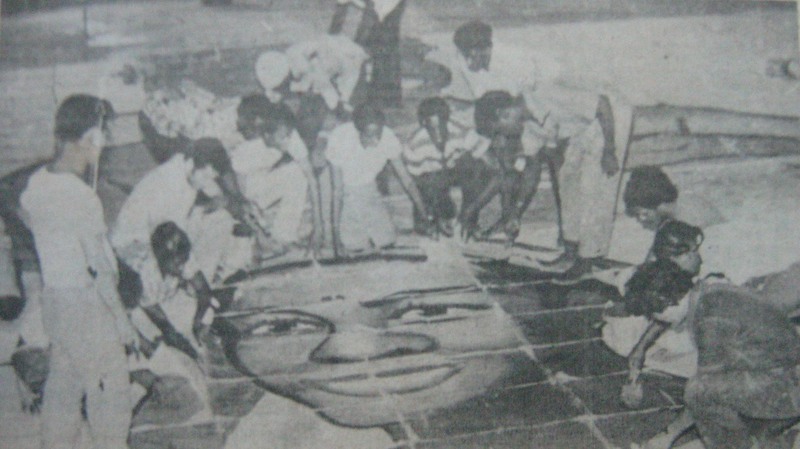
The mass games are an enormous part of north Korean culture. They’re seen as education, ideological development, community cohesion, exercise and cultural expression all in one. It is a statement of intent for the entire country and its people show their single hearted unity through this. So, in September of 1979, relations seemed to hit a zenith as Korean mass games visual artist Kim Il-Nam arrived in Guyana with the expressed purpose of bringing the mass games to Guyana. He had been specially selected by Kim Il-Sung and spent months researching Guyanese history and culture to better understand how to cross this art form over.
The first mass games was a true national event. Burnham regularly sat in on rehearsals to see how things were progressing and some of Guyana’s best performers were commissioned to get it as good as it could possibly be. The memoirs of Jesuit priest Andrew Morrison, who was present at the time, suggest that eight tons of decorations were imported from Korea, a hundred thousand balloons were imported from America and a further two hundred thousand buttons were commissioned with Burnham’s face on them, much like the iconic badges worn in Korea. Wearing them was not state-mandated, nor did the state have a strong enough infrastructure to enforce such a thing, so the wearing of them was never widespread. Nonetheless, it’s an interesting example of how close relations truly were.
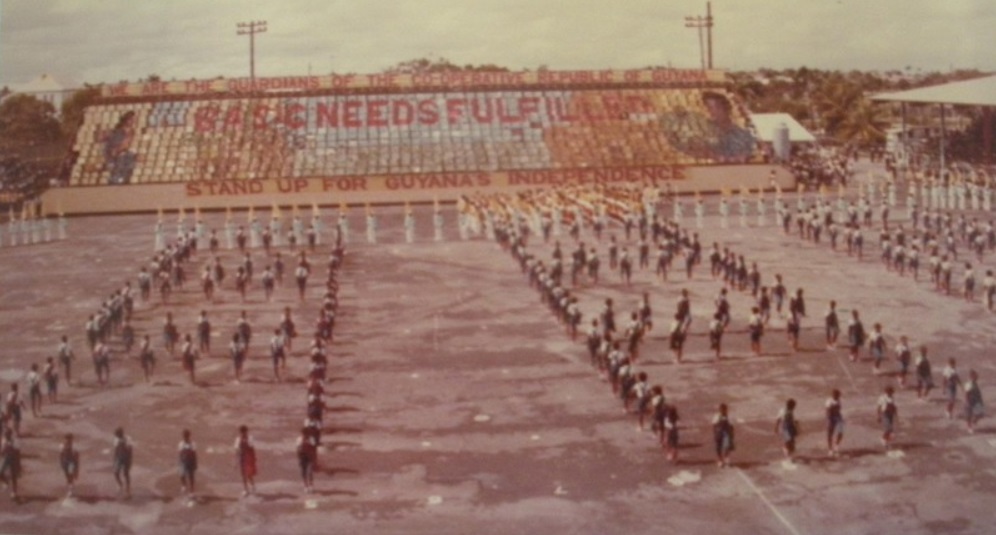
On the 23rd of February 1980, the first Guyana mass games commenced. The performance was very Korean inspired. It began with a re-enactment of the proclamation of the co-operative republic ten years earlier, leading on to performances of industry, agriculture, education, defence and the national ‘feed, clothe and house’ program. The final portion focused on international relations, no doubt as a nod to their Korean allies, with the performance ending after ninety minutes, as is standard in Korea. The performance reportedly involved 3000 students, with 780 forming the moving backdrop that is so iconic to their Korean counterpart.
With their work done, the Korean instructors spent nine months teaching their Guyanese counterparts and then left, letting the games continue on a yearly basis from then on, constantly growing in size and scale. It became part of a student’s standard curriculum to participate and tweaks to the formula gave it a more Caribbean flair as instruments like steel drums took over from the traditional orchestra. My primary source for this piece at one point interviewed Yolanda Marshall, a Guyanese writer who participated in the 1983 mass games and asked her to compare them with the Korean mass games and she had this to say:
It is very similar, in terms of the display cards and gymnastics etc. Our Mass Games was like a well-organized Carnival show. Bigger, brighter costumes, Caribbean music, dances etc. Our Mass Games resembled some type of an African celebration from slavery with a mixture of militancy and blending of cultures. I personally feel my Guyanese Mass Games was more fun, after all, most Guyanese love to dance to good music
Yolanda Marshall
Much like the Korean mass games, Guyana’s tended to follow different themes. The last mass games under Burnham was the 1985 games which focused on the nation’s youth. The 1986 mass games was entitled ‘Standing up for Guyana’. 1987 was ‘Guyana – Oh Beautiful Guyana’ which focused more on natural beauty, broad patriotism and support for the president. By this stage of course, ideology was being de-emphasised as the post-Burnham era led to a move away from socialism.
What Happened to the Guyana Mass Games?
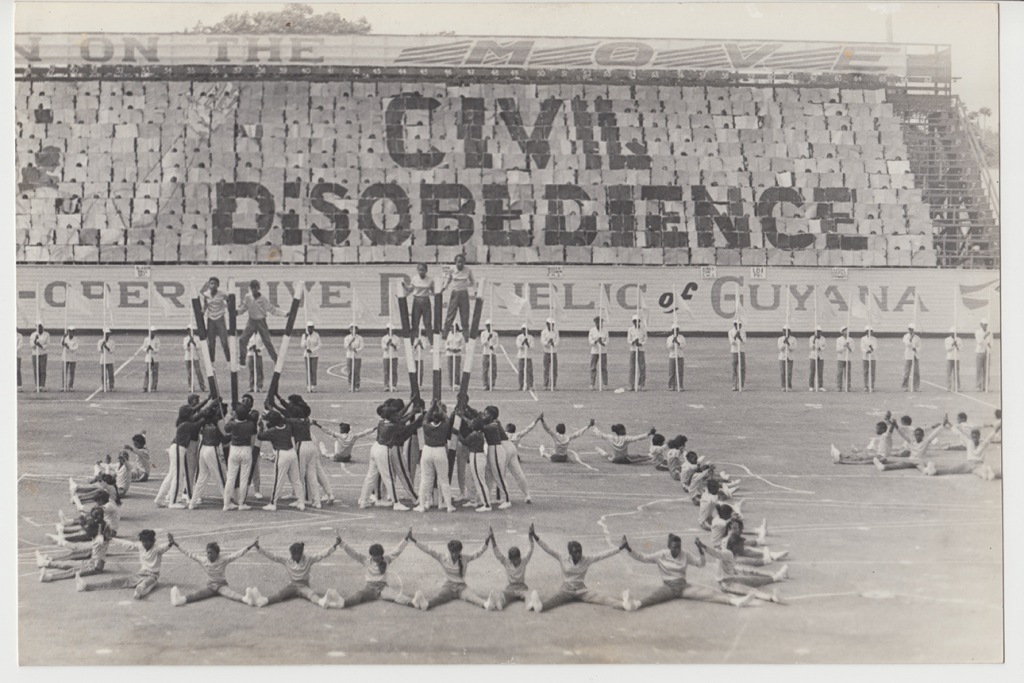
By 1988, the socialist bloc internationally was beginning to waver and long-simmering tensions were building within Guyana. Fingers were soon pointed at the mass games and a loosened political atmosphere allowed for discourse to begin on the subject. Novelist Ian McDonald in particular launched a scathing attack on the mass games as being non-Guyanese and a waste of time for the nation’s youth.
There may at first have been nothing wrong in at least trying a kind of exercise that produced such spectacular and colorful examples of mass popular discipline in other countries. Nothing wrong with experimenting. But the simple truth is that Guyana is not North Korea and it is surely obvious by now that the idea has not travelled well. It is not for us. It does not fit our psyche. The attempt to enforce mass discipline and call it fun does not suit our temperament, our traditions, or our deepest inclinations. Let us admire the massed phalanxes of North Korean children as they wave and smile and dip and move and gyrate in strict unison. But let us admire from afar.
Ian McDonald
While the party argued back against him and that year’s mass games went ahead, it surely spelled the beginning of the end. In 1992, free elections were called and the ruling party was swept out of office, paving the way for the mass games to be discontinued and their legacy all but erased from history books. Rather effectively it would seem, as there are hardly even any photographs of this more than decade-spanning annual event, the only one of its kind in the western hemisphere.
With the event over, all we have to look back on is its legacy. The earlier mentioned Yolanda Marshall sees its legacy in a positive light, gladly recalling the brightness and fun of a unifying performance of dance and culture. The Burnham era in general is not particularly looked back on with horror and dismay, having seen comparatively little in the way of state violence and having overseen a boom in education, housing and at least in parts of the economy. The nation in the west to have been most like north Korea doesn’t seem particularly worse off for it. Who knows, nostalgia for the era may grow to such a point that the mass games return. Only time will tell.
If you want to learn more about this fascinating and under-researched country, you should consider coming along with us on our October expedition to Guyana, Suriname and French Guinea!





